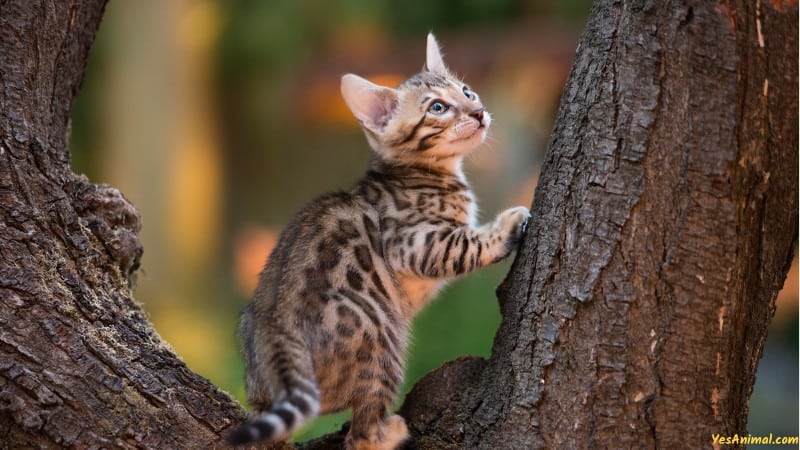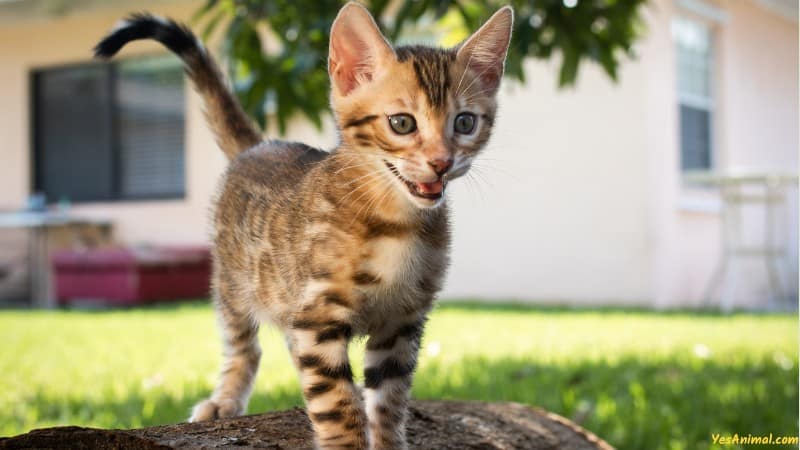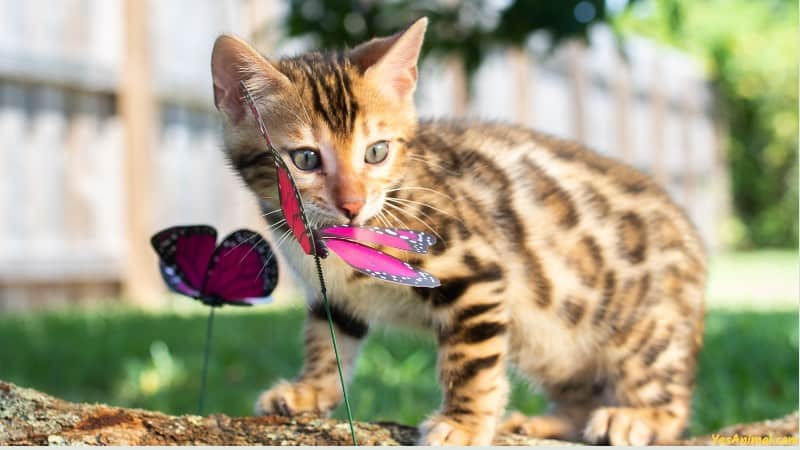Last Updated on July 14, 2024 by Amin Tawar
Bengal Kitten Size ( With Bengal kitten Growth Chart)

Bengal kittens are miniature versions of their wild ancestors, but with a domestic twist. They are known for their striking appearance, with their distinctive markings and lush coats, but their size is just as noteworthy.
So, what is the size of a Bengal kitten, and how do they grow? Let’s take a look at a Bengal kitten growth chart to get a better understanding.
On average, Bengal kittens are born weighing between 100-150 grams and reach their full adult size at around 3 years old. In the first year, Bengal kittens grow rapidly, with their weight tripling within the first six months. At 6 months, the average weight of a Bengal kitten is around 3.5 kg (7.7 lbs), with males being slightly larger than females.
As they enter their second year, their growth rate slows down, and they continue to fill out and develop muscle mass. By the end of their second year, the average weight of a Bengal cat is around 5-6 kg (11-13 lbs).
In their third year, Bengal cats will have reached their full size, and their weight will not change much, if at all. Males tend to be larger, with an average weight of 7-8 kg, while females average 5-6 kg.
| Bengal kitten Age | Length (inches) | Weight (pounds) |
| 1 Month | 8-10” | 1.5-2.5 lbs |
| 2 Months | 12-14” | 2.5-4.0 lbs |
| 3 Months | 14-16” | 4.0-5.5 lbs |
| 4 Months | 16-18” | 5.5-6.5 lbs |
| 5 Months | 18-20” | 6.5-7.5 lbs |
| 6 Months | 20-22” | 7.5-9.0 lbs |
| 7 Months | 22-24” | 9.0-10.5 lbs |
| 8 Months | 24-26” | 10.5-12.0 lbs |
| 9 Months | 26-28” | 12.0-13.0 lbs |
| 10 Months | 28-30” | 13.0-14.0 lbs |
| 1 Year | 30-32” | 14.0-15.0 lbs |
| 18 Months | 32-34” | 15.0-16.0 lbs |
| 2 Years | 34-36” | 16.0-17.0 lbs |
| 3 Years | 36-38” | 17.0-20.0 lbs |
What Does A Bengal Kitten Look Like? All Color Options

Bengal kittens are not just known for their impressive size, but also for their unique and striking appearance. With their wild heritage and domestic upbringing, Bengal kittens come in a range of colors, patterns, and markings that are truly one-of-a-kind. So, what exactly does a Bengal kitten look like, and what colors can they come in? Let’s take a closer look.
Bengal kittens are characterized by their distinctive, marbled coats that resemble the markings found on wild leopards or jaguars.
Their fur is typically soft and silky, with a luxurious sheen that adds to their overall beauty. They also have large, round eyes that are usually green or gold, and sharp, expressive features that give them a playful and mischievous expression.
When it comes to color, Bengal kittens can come in a wide range of shades, from warm golden hues to rich browns, black, and even snow-white. The most common colors for Bengal kittens are brown tabby, seal lynx point, silver, and charcoal.
However, some Bengal kittens may also have a pattern known as “glitter,” which gives their fur a shimmering, metallic appearance.
Bengal Kitten Behaviour: Are Bengal Kittens Friendly Or Aggressive?
Bengal kittens may look wild and exotic, but their behavior is anything but. They are known for their playful, curious, and affectionate personalities, and are often described as being “dog-like” in their behavior.
One of the defining characteristics of Bengal kittens is their intelligence and playful nature. They are active, and energetic, and enjoy exploring their environment, and they often engage in games of chase and hide-and-seek. They are also quick learners and enjoy interactive toys, such as puzzle feeders, that challenge their minds.
In terms of social behavior, Bengal kittens are generally friendly and affectionate with their owners and family members.
They enjoy being petted, cuddled, and played with, and often follow their owners around the house, seeking attention and affection. They are also often good with children and other pets, but this can vary from cat to cat.
Bengal Kitten Diet

Just like with any other living creature, what you feed your Bengal kitten is critical to its health and well-being. These energetic and playful creatures have specific dietary needs, and it’s important to know what to feed them to ensure they grow up to be happy and healthy.
Bengal kittens require a balanced diet that includes high-quality protein from animal sources, essential fatty acids, and a moderate amount of carbohydrates.
It’s important to feed them several small meals a day, instead of just one or two large meals, to help them maintain their high metabolism. Wet food is an excellent choice for Bengal kittens because it contains a higher amount of moisture, which is important for their overall health.
Additionally, supplementing their diet with essential vitamins and minerals, such as taurine and Vitamin A, is crucial for the development of their eyes, heart, and muscles.
Treats should be given in moderation and should not make up more than 10% of their daily caloric intake. To ensure your Bengal kitten stays healthy and energetic, it’s important to talk to your veterinarian about the best dietary options for them.
Do Bengal Kittens Sleep & Shed A Lot?
Yes, Bengal kittens do sleep, and just like other kittens, they require a lot of rest to support their growth and development. It’s not uncommon for them to sleep for up to 18 hours a day, especially during their first few months of life.
Bengal kittens are known for their energy and playfulness, so it’s important to make sure they have plenty of opportunities to run, play, and expend energy during the day. This will help them sleep better at night and stay healthy overall.
As for shedding, Bengal kittens do shed, but the amount of shedding varies depending on the individual cat. Some Bengal kittens may shed very little, while others may shed more.
The frequency of shedding also varies, with some cats shedding more in the spring and fall and less in the winter and summer.
Brushing your Bengal kitten regularly can help reduce shedding and distribute its natural oils evenly through its coat, keeping it shiny and healthy. If you notice excessive shedding or any changes in your coat, it’s a good idea to talk to your veterinarian to rule out any underlying health issues.
Do Bengal Kittens Meow A Lot?
Bengal kittens, like all cats, do meow, but the frequency and volume of their meowing can vary greatly depending on the individual. Some Bengal kittens may meow a lot, while others may be quieter and more reserved.
Bengal kittens are known for their chatty and playful personalities, so it’s not unusual for them to meow more than other breeds. They may meow to get attention, communicate hunger or discomfort, or simply because they want to play.
It’s important to remember that meowing is a normal and natural part of a Bengal kitten’s behavior, and it’s usually nothing to be concerned about.
However, if your Bengal kitten is meowing excessively or you notice any changes in its meowing pattern, it’s a good idea to talk to your veterinarian to rule out any underlying health issues.
With the right care and attention, your Bengal kitten’s meowing will add to its charm and become an endearing part of its personality.
Bengal Kitten Lifespan: What Is The Survival Rate Of Bengal Kittens?

Did you know that with proper care, Bengal kittens have the potential to live long and healthy lives? The lifespan of Bengal kittens can vary depending on several factors, including genetics, diet, exercise, and overall health. On average, Bengal kittens can live for 12-16 years, with some living even longer with proper care.
The survival rate of Bengal kittens is generally good, especially if they are raised in a healthy and safe environment and receive proper veterinary care. Keeping your Bengal kitten up-to-date on vaccinations and routine check-ups with your veterinarian can help prevent illness and disease, and ensure they live a long and healthy life.
It’s important to note that the survival rate of Bengal kittens can also be affected by other factors such as their living environment, access to food and water, and exposure to diseases and parasites.
Bengal Kitten Care Tips
With their wild beauty and playful personalities, Bengal kittens require a unique touch of care and attention to thrive.
Here are some tips for taking care of your Bengal kitten:
- Provide a safe and comfortable living environment: Bengal kittens love to play and explore, so make sure their living environment is safe and free of potential hazards.
- Feed a balanced diet: Feed your Bengal kitten high-quality cat food that is appropriate for their age, size, and activity level. Wet food is a great option for Bengal kittens.
- Keep them active: Bengal kittens are energetic and playful, so make sure to provide them with plenty of toys and opportunities to play and run around.
- Keep their coat clean and shiny: Regular grooming, including brushing their fur and bathing as needed, will help keep their coat healthy and shiny.
- Provide regular veterinary care: Regular check-ups with your veterinarian, including vaccinations and parasite control, are important for your Bengal kitten’s overall health.
- Socialize them early: Bengal kittens are social animals, so make sure to socialize them with people and other pets from an early age.
By following these care tips, you can help ensure your Bengal kitten grows into a happy, healthy, and well-adjusted adult cat. 1
How Much Does A Bengal Kitten Cost? (US, UK, Canada, India, Australia,)
The cost of a Bengal kitten can vary greatly depending on the location, breeder, and the individual kitten itself. Here is a general idea of the cost of a Bengal kitten in different countries:
| Country | Cost of Bengal Kitten |
| United States | $1,000 – $3,000 or more |
| United Kingdom | £600 – £1,500 or more |
| Canada | CAD 1,500 – CAD 2,500 or more |
| India | INR 50,000 – INR 100,000 or more |
| Australia | AUD 1,500 – AUD 2,500 or more |
Additionally, when looking to purchase a Bengal kitten, it’s important to find a reputable breeder who follows responsible breeding practices and to make sure the kitten is healthy and well-socialized. While the cost of a Bengal kitten can be high, the companionship and joy they bring to your life are priceless.
Are Bengal kittens Good Pets?
With their playful nature and striking appearance, Bengal kittens have the power to captivate even the most discerning of pet lovers.
Bengal kittens can make great pets for the right owner. They are highly active and energetic, which can be both a blessing and a challenge. They love to play and explore, and their natural curiosity can lead them into all sorts of mischief. They are also intelligent and highly trainable, making them quick learners and responsive to positive reinforcement training methods.
However, it’s important to keep in mind that Bengal kittens are a high-maintenance breed that requires a lot of time, attention, and patience. They are not suitable for everyone, especially those who are not prepared to meet their high energy and activity levels.
Bengal Kitten Compared To Regular Kitten
Imagine a kitten with the energy of a cheetah and the beauty of a leopard – that’s what a Bengal kitten is like compared to a regular kitten.
Bengal kittens differ from regular kittens in several key ways. They are a hybrid breed that was created by breeding an Asian leopard cat with a domestic cat. This has given them a unique appearance, with a distinctive coat pattern that resembles that of a wild cat.
Bengal kittens are also much more active and energetic than regular kittens. They are known for their high energy levels and love of play, which can make them a handful for owners who are not prepared for a highly active pet.
They are also more intelligent and trainable than regular kittens, which can make them quick learners and responsive to positive reinforcement training methods.
Conclusion
And that was everything you need to know about the Bengal Kitten. I hope this article was informative enough and your queries were answered.
Thank You For Reading!
Related Articles You May Like